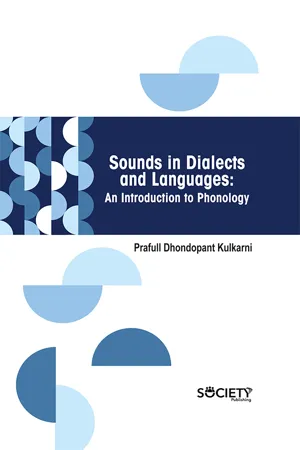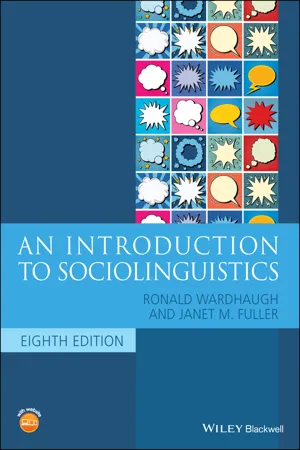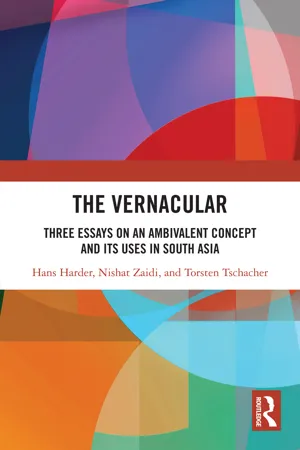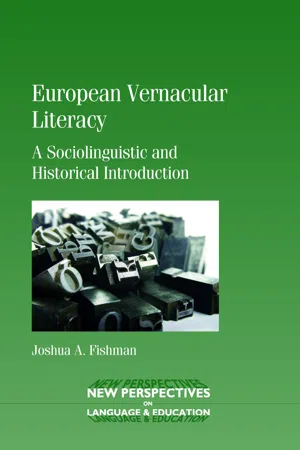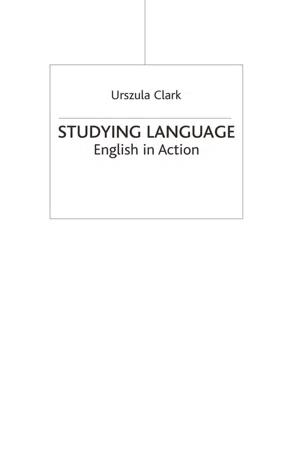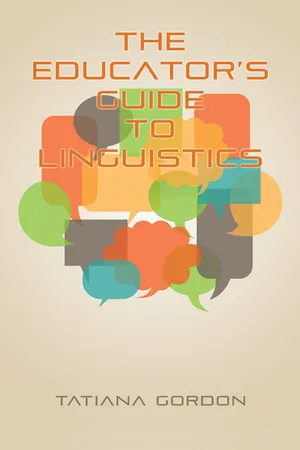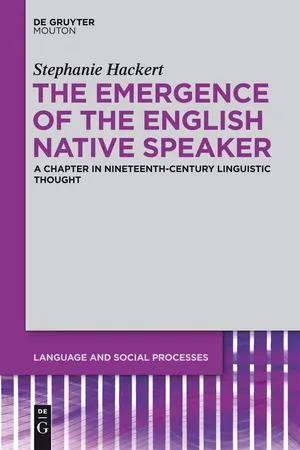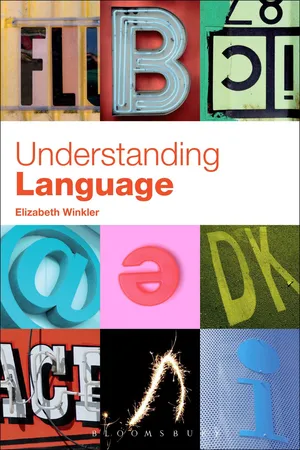Languages & Linguistics
Vernacular English
Vernacular English refers to the everyday spoken language used by a particular group of people in a specific region. It encompasses the informal, colloquial, and non-standard varieties of English, often characterized by unique vocabulary, grammar, and pronunciation. Vernacular English reflects the cultural and social identity of its speakers and is distinct from formal or standardized forms of the language.
Written by Perlego with AI-assistance
Related key terms
1 of 5
10 Key excerpts on "Vernacular English"
- eBook - PDF
Ebonics
The Urban Education Debate
- David J Ramirez, Terrence Wiley, Gerda de Klerk, Enid Lee, Wayne E. Wright(Authors)
- 2005(Publication Date)
- Multilingual Matters(Publisher)
By vernacular I mean more generally ‘the everyday [and informal] language spoken by a people as distinguished from the literary language’ ( American Heritage Dictionary of the English Language , 1992: 1984). More specifically I am thinking of vernacular dialects, ‘which seem to be typified by the use of nonstandard forms’ (Wolfram & Schilling-Estes, 1998: 13). By standard , and more specifically Standard English , I mean ‘the variety normally used in writing, especially 18 printing; . . . the variety associated with the education system . . . the variety spoken by those who are often referred to as ‘‘educated people’’’ (Trudgill, 1999: 2 / 3). As Wolfram and Schilling-Estes (1998: 12) note, what linguists call standard or mainstream English is often referred to popularly (if ambiguously) as ‘correct English’ or ‘proper English’. These two terms tend to be defined in a negative fashion by saying, ‘if a person’s speech is free of structures that can be identified as nonstandard [e.g. ain’t for ‘isn’t’], then it is considered standard’ (Wolfram & Schilling-Estes, 1998: 12). 4 Most of what was written and said in the media after the Oakland Ebonics resolution of December 1996 represented a misapprehension of the nature of the problem the Oakland School Board faced and the nature of the solution it was proposing. Most writers and commentators emphasized the importance of children learning Standard English in this society. In response to this, the Oakland School Board might simply have replied, ‘Yes, we agree. But what’s next? How are we going to achieve that?’ How (Badly) Schools Have Failed to Educate African American Students Oakland’s original aim was to extend the Standard English Proficiency [SEP] program which had been in place since 1981 throughout the state. The goal of this program is to use the vernacular to teach the standard. - Prafull Dhondopant Kulkarni(Author)
- 2023(Publication Date)
- Society Publishing(Publisher)
Variation or Dialect 227 Figure 8.2: Dialect map of modern Greek, English version. Source: Image by Wikimedia Commons. Vernacular is depicted as the absence of glory, and it is inaccurate, unacceptable, and it doesn’t comply with the guidelines of language. This citation presents the defence clearly and empowers a language to be considered as a language, for example (has status, standard, useful, esteemed, and composed) and these properties are connected with language and tongue needs. 8.4.1. Vernacular and Region In the high-level countries, the area no longer keeps up with its status. A lot many changes in urbanization, versatility, embourgeoisement, education, and other social elements have prompted a severe evening out of provincial tongues and accents. Labov (1972) says “My investigations of on-going etymological changes demonstrate that vernacular expansion is proceeding… disregarding close contact among the gatherings in question.” For over a century, dialectologists were initially worried about where their sources resided, and they began their fieldworkers likewise, from Edmond Sounds in Dialects and Languages: An Introduction to Phonology 228 moving by cycle through the French country regions gathering information for the Atlas Linguistique de France in 1896–1900 to Raven I. McDavid motored around the eastern ocean side of the United States gathering field records for the Linguistic Atlas of the Middle and the Southern Atlantic States from 1945 to 1949. Furthermore, for those years, dialectology was fundamentally vernacular topography thinking about the area as a free factor (Figure 8.3). Figure 8.3: A page is written in the Kurdish Sorani dialect with corresponding Arabic words. Source: Image by Wikimedia Commons. Wireless and different authors of dialectology were persuaded about the connection between tongue assortment and nearby scenes.- eBook - PDF
- Ronald Wardhaugh, Janet M. Fuller(Authors)
- 2021(Publication Date)
- Wiley-Blackwell(Publisher)
In these cases, many people see language and ethnicity or nationality as virtu- ally synonymous (Coulmas 1999). However, for many people, there is no one-to-one correla- tion between these categories; some people are both Chinese and French, or may identify as simply Canadian, not Korean Canadian, regardless of what languages they speak. Most people can give a name to their language(s). On occasion, some of these names may appear to be strange to those who take a scientific interest in languages, but we should remember that human naming practices often have a large ‘unscientific’ component to them. Census-takers in India find themselves confronted with a wide array of language names when they ask people what language or languages they speak. Names are not only ascribed by region, which is what we might expect, but sometimes also by caste, religion, village, and so on (see Mallikarjun 2002). Moreover, they can change from census to cen- sus as the political and social climate of the country changes. Linguists use the term vernacular to refer to the language a person grows up with and uses in everyday life in ordinary, commonplace, social interactions. We should note that so-called vernaculars may meet with social disapproval from others who favor another variety, especially if they favor a variety heavily influenced by the written form of the lan- guage. Therefore, this term often has pejorative associations when used in public discourse. The vernacular is often contrasted with a standardized language, which we will discuss in depth below. Haugen (1966) has pointed out that language and dialect are ambiguous terms. Although ordinary people use these terms quite freely in speech, for them a dialect is almost certainly no more than a local non-prestigious (therefore powerless) variety of a ‘real’ language. In contrast, scholars may experience considerable difficulty in deciding whether one term should be used rather than the other in certain situations. - eBook - ePub
The Vernacular
Three Essays on an Ambivalent Concept and its Uses in South Asia
- Hans Harder, Nishat Zaidi, Torsten Tschacher(Authors)
- 2023(Publication Date)
- Routledge India(Publisher)
If employed without further explanations in Anglophone contexts on the Indian subcontinent, the term is readily understood today as referring to the non-English, spoken languages of South Asia. In this broadest sense, the vernacular or vernaculars in the plural thus have the potential to tie together a huge and very uneven array of hundreds of languages of different origins, statuses, ages, and sizes. As an umbrella term, vernacular is even more comprehensive than the denomination ‘regional languages’ for an overlapping category, since vernacular is open-ended and ready to capture the largest linguistic formations, such as Hindu-Urdu, together with the tiniest isolated varieties with very few speakers, such as certain ‘tribal languages.’ Vernacular in this sense readily comprises varieties of different linguistic stock, such as New Indo-Aryan, Dravidian, Austro-Asiatic, Iranian, Sino-Tibetan languages; it also brings together languages of great formal status and longstanding literary dominance – national and state languages – with unscripted and often endangered languages fighting for official recognition. But this great potential of vernacular of encompassing things very differently placed on the scales of prestige is not what we usually foreground when we use it. More often than not, in South Asia, vernacular serves merely to distinguish certain linguistic contexts (literary or filmic productions in whatever language at hand) from English ones. By extension, vernacular in South Asia also commonly refers to social settings, cultural spheres, and, particularly, architectonical traditions of local or regional origins – again in contradistinction to spheres or traditions connected with the colonial power or the globalised English-speaking world.However, this generalising use of vernacular as the collective, all-comprising Other of English on the Indian subcontinent, and thus as a comparatively powerless ensemble, has not remained uncontested. Sheldon Pollock’s model of vernacularisation does not apply to all the linguistic varieties mentioned above, and of course not in contradistinction to English, but to Sanskrit and other classical languages, and only to those that came to articulate regional authority or dominance (Pollock 2006 ). Partly along these lines, Ritipuspa Mishra has recently pointed out that the perception of powerlessness conceals the power with which certain vernaculars were invested by colonial policies and which they continue to command by the formation of linguistic states in postcolonial India (Mishra 2020 - eBook - ePub
European Vernacular Literacy
A Sociolinguistic and Historical Introduction
- Joshua A. Fishman(Author)
- 2010(Publication Date)
- Multilingual Matters(Publisher)
Chapter 2 What is a ‘Language’ of Vernacular Literacy?Many crucial terms used in the social sciences are also used in everyday speech. The only problem is that in everyday usage terms are rarely precisely defined in advance. As a result, many a conversation that has gone on for hours may grind to a halt because one participant or another exclaims ‘But that is not what I mean when I say “freedom” (or “democracy”, or “peace”, or whatever)!’ In order for us not to be faced by any such problem after many pages, or even chapters, of our discussion, let us start by immediately defining the terms ‘language’. Does ‘slang’ qualify to be called a language? Does ‘Southern English’, like the kind that is spoken informally by many native residents of rural Mississippi, qualify? Does the native speech of recent Japanese immigrants from Okinawa, or that of newcomers to the US mainland from the coffee plantations near the southern coast of Puerto Rico or does the Spanish from ‘South of the border, down Mexico way’, qualify, because ‘almost everyone’s parents were native-speakers of either Spanish or one or another Amerindian language, all of which arrived here even before English did’? Does a spoken variety qualify even if it has no written counterpart at all, or even if it has no writing system? It would be good to get some of these questions clarified from the very beginning (not that full agreement may necessarily be reached even after ample discussion), so that we can all at least know if we are ‘on the same page’, even if we are not all on the same line of that page.A Dictionary Definition
A commonly used unabridged dictionary suggests a typical beginning definition of language as: ‘the way human beings communicate using words, whether written or spoken. It is also used for the particular system of communication used by a specific country, nation or community’ (Encarta, 1999: 1013). This particular dictionary then goes on to explain that ‘language’ is not the only way that individuals communicate and that it includes such subsidiary varieties as idiolects, dialects, slang, jargon, parlance, lingo, etc. The above overall definition could easily be ‘filled out’ by mentioning various further varieties of language, for example, occupational varieties, levels of formality in language, levels of seriousness in language, use of metaphor in language, related and unrelated languages, child language, animal languages, disturbed language, international and classical languages and so on. Gradually, what we originally took to be a simple, popular term, with a common meaning easily available to one and all, manifests itself to be full of unexpected complexities related to its widely differentiated users and uses. Obviously, only a modicum of reflection has revealed that there is nothing at all inherently simple about words such as ‘language’ and ‘languages’, since they reflect and convey all of the motivational and behavioral differences of the species that employ them, both to reveal and to disguise their goals, values and characteristics. - eBook - PDF
Studying Language
English in Action
- Urszula Clark(Author)
- 2017(Publication Date)
- Red Globe Press(Publisher)
CHAPTER Variation and Change in 1 English ❙ 1.1 Introduction Linguistics is concerned with the study of language, including theories of lan-guage and the ways in which a language is structured and patterned . Language can be theorised and described in a general and abstract way, or a particular language can be categorised and described. However when we look at how language is actually used in everyday life it becomes clear that, far from being spoken and written in exactly the same way by everybody, it is in fact tremendously varied. This chapter considers different spoken varieties of English and the extent to which the society and communities in which we live affect the ways in which we speak and write. Section 1.2 begins by defining ‘language’, ‘dialect’, ‘accent’, ‘variety’ and ‘standard’ English, and then considers people’s attitudes towards variations in language use. Section 1.3 outlines the history of the standardisation of English in order to illustrate why dialectal variations persist in England and the United Kingdom as a whole. This section also traces the origins of preju-dice against variations that continues to this day. In the United States the processes of standardisation have been very different from those in England. The resultant variations are fewer than in the United Kingdom and there is less prejudice against them. Our investigation of these two examples shows that linguistic variations depend a great deal on specific social, economic, political, geographic and historical variables. Section 1.4 discusses two methodological approaches to research into vari-ation, the first of which focuses on linguistic variables and the second on social variables and social networks. Investigation of variations in phonology, morphology and syntax is the realm of traditional dialectology and can be found in regional studies such as The Survey of English Dialects (Orton, 1962) 3 and A Handbook of Varieties of English (Kortmann and Schneider, 2004). - eBook - PDF
- Tatiana Gordon(Author)
- 2008(Publication Date)
- Information Age Publishing(Publisher)
Language Variation 137 Some sociolinguists contend that men favor vernacular language be- cause it is associated with physical strength and manual labor and hence con- veys masculinity. Linguistic Prestige and Accommodation Vernaculars and standard languages are not perceived in the same way. Speakers often feel that the standard variety is singularly expressive, ele- gant, and beautiful. In contrast, the vernacular or regional dialect may be denigrated as “crude,” “uneducated,” or “illiterate.” Speakers of vernacu- lars are often criticized for what is presumed to be their sloppy or careless use of language. It is not only people from outside vernacular speech communities who pass such judgments. Users of vernaculars themselves often suffer from lin- guistic insecurity, or a negative perception of their own speech variety. For example, speakers of low-caste dialects in India or Brooklynese may feel that their dialect is inferior to the standard form. These negative attitudes are misconceived. It is important to bear in mind that no language form is inherently inferior. Take double negative, a salient feature of many English vernaculars. Patterns such as I didn’t do nothing or We didn’t go nowhere are sometimes decried as being “illogical.” And yet, double negative was once a feature of standard English and is still found in standard varieties of many languages. Consider another example. While r-lessness may be admired in British English, this very same feature may be found crude when it crops up in Brooklynese or the Southern ver- nacular of American English. What these examples suggest is that the high prestige of standard dialects is related to the privileged status of their speak- ers. Normally, a variety used by an influential group carries higher prestige. While non-standard language patterns are frowned upon, they are still pervasive. The popular coffee shop is called Dunkin’ Donut, not Dunking Donuts. A pop singer croons We are jammin’, not We are jamming. - eBook - PDF
The Emergence of the English Native Speaker
A Chapter in Nineteenth-Century Linguistic Thought
- Stephanie Hackert(Author)
- 2012(Publication Date)
- De Gruyter Mouton(Publisher)
While modern sociolinguistics, especially of the variationist tradition, has put much effort into demonstrating that languages and dialects are not homogene-ous and uniform in reality but evidence systematic patterning both diachroni-cally and synchronically, some of the traditional assumptions just sketched have remained. There is, still, the focus on “natural” or “authentic” styles, and the “quest for the vernacular” can be described as the holy grail of sociolinguistic methodology. Even though the vernacular is assumed to be inherently variable, this variability is seen as more systematic than that extant in the standard-influ-enced styles acquired later in life. The vernacular is thus the speech style that is considered most representative of a speaker’s or a speech community’s grammar and therefore of the greatest interest to the linguist both theoretically and meth-odologically, while the standard constitutes a more formal, “super-posed” style which rarely yields “systematic data” (Labov 1984: 29). This assumption has only recently been questioned. Singler (2007: 126–127), for example, says that, [a]fter all, the assertion that casual speech is more “systematic” than careful speech is axi-omatic and has not to my knowledge been proven (if, indeed, it is provable). Further, the statement that the vernacular (casual speech) “gives us the most systematic data for our analysis of linguistic structure” need not imply that careful speech is a-systematic. The standard and the dialects 147 One of the fundamental problems of sociolinguistics is the contradiction between the quest for the vernacular and what has been labeled the “observer’s paradox” (1984: 30), i.e., the fact that the mere presence of a researcher will induce a speaker to shift to more formal and therefore less systematic speech styles. - eBook - PDF
- Ladislav Zgusta, Vera Cerny(Authors)
- 2010(Publication Date)
- De Gruyter Mouton(Publisher)
(2) Colloquial language is the form of the standard national language which is spoken in private and in semi-official situations (business etc.) by people of average and higher education. Both the literary and the spoken culti-vated language and the colloquial language are also used, in their proper spheres, in the areas where there are dialects. The typical situation in countries with compulsory school education is that some knowledge of the standard national language is constantly spread by the schools; this development is fostered by the apparatus of the state administration, by commerce and other interdialectal contacts, and especially by the modern means of mass communi-cation, namely books, newspapers, radio, cinema and television. As a result, a good part or even the majority of speakers of dialects also know the standard 12 There are possible terminological differences. Some linguists term this a dialect, too, and reserve the term language only for the sum of all the varieties. VARIATION IN LANGUAGE 171 national language, 13 at least in some form and to some extent, and are ready to use it in a suitable out-of-the-daily-life situation. Sometimes isolated dialectal features do penetrate into the standard language; they are called dialectisms. Usually only few of them can be observed in the literary lan-guage if it is well stabilized and has some tradition, 14 slightly more in the spoken cultivated, and substantially more in the colloquial language. The parallel term colloquialism designates those elements of the colloquial language which are typical for it and which do not occur in the litterary language, at least not as normal means of cummunication, without a stylistic effect. - No longer available |Learn more
Understanding Language
A Basic Course in Linguistics
- Elizabeth Grace Winkler, Elizabeth Winkler(Authors)
- 2012(Publication Date)
- Continuum(Publisher)
4.2. African American Vernacular English That mainstream English is essential to our self preservation is indisput-able but it is not necessary to abandon Spoken Soul to Master Standard English, any more than it is necessary to abandon English to French or to depreciate jazz to appreciate classical music. (John R. Rickford and Russell J. Rickford, 2000) Ebonics? Black English? Black Vernacular English? African American English? African American Vernacular English? These popular and linguistic Understanding Language 296 Features of African American Vernacular English Some of the most recognizable differences in the speech of AAVE speakers are the differences in the sound system. Many people even claim to be able names, old and new, refer to a group of systematic language varieties spo-ken by many black Americans, and others, throughout the United States. Just as with SAE, African American English is an abstract concept. Not all African Americans speak it or any of its variations, and not all of its speak-ers are African Americans. Just as with any other dialect, its speakers apply its rules in varying degrees, and just like other dialects, it rules are applied systematically. The history of these varieties is part of the history of slavery and the devel-opment of pidgins and creoles discussed in an earlier section of this chapter. Suffice it to say that African American varieties of English have features that can be traced to Niger-Congo (NC) languages of West Africa, and other fea-tures which can be traced to varieties of settler English including Scots and Irish varieties of English, now Appalachian English (AE) and Southern White Vernacular English as well. This history is significant, among other reasons, because the linguistic status, especially of the most radical form, African American Vernacular English (AAVE, also called Ebonics), is still hotly debated in some circles.
Index pages curate the most relevant extracts from our library of academic textbooks. They’ve been created using an in-house natural language model (NLM), each adding context and meaning to key research topics.

